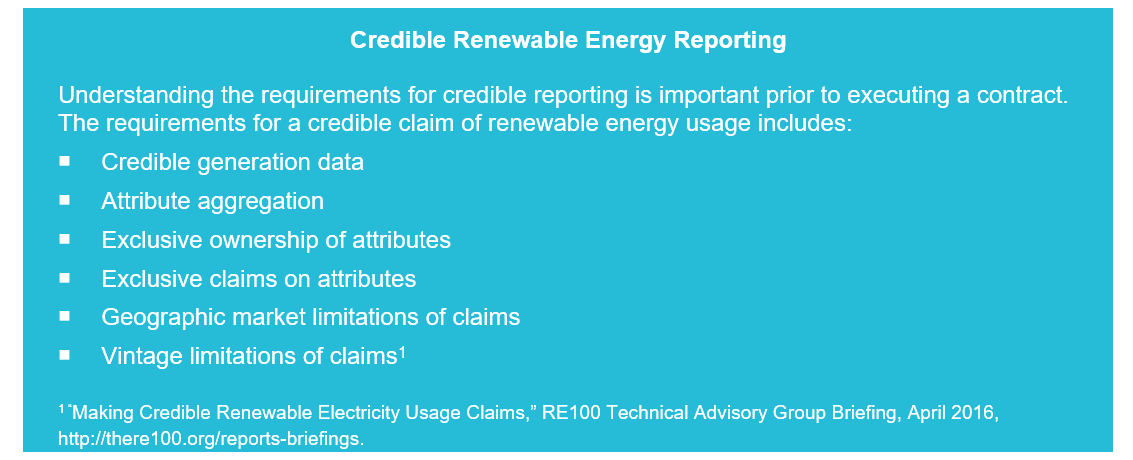Corporate Renewable Energy Program
The private sector is increasingly turning to renewable energy to achieve corporate sustainability goals . In order to accomplish this successfully, these companies depend on a clear corporate renewable energy program. A corporate renewable energy program is an implementation and management framework to help companies integrate renewable energy into their business operations. An effective program will include a clear goal (e.g., 100% renewable energy sourcing), a defined procurement strategy (e.g., renewable energy certificates (RECs), power purchase agreements (PPAs), etc.), and an iterative underlying process for ongoing management.
There is a range of corporate renewable energy goals and diverse strategies available to achieve them. Strategies include developing customer-owned on-site generation, purchasing RECs, participating in utility green tariffs, or signing a PPA directly with an on-site or off-site renewable energy project.
While RECs continue to be the primary approach to renewable energy procurement in the United States, corporate renewable PPAs and other installation contracts are becoming increasingly popular. For example, in 2016, companies aiming to achieve 100% renewable energy sourced 20% of the 11.6 TWh procured through corporate renewable programs from corporate renewable PPAs, a substantial jump from a mere 1% in 2015.
Regardless of a company’s goal and strategy, ScottMadden has identified four key factors that make up a successful corporate renewable program:
- A plan that aligns a company’s renewable goal and strategy with its business strategies
- Consistent execution and attention to all facets of the renewable strategy
- Pre-determined reporting metrics
- Internal and external integration throughout business operations
As detailed in Figure 1, these four factors are not linear, and companies should refine them throughout the process. A comprehensive and carefully executed program can help a company successfully transition toward renewable energy and achieve its energy goals.
Figure 1: Four Factors for a Successful Corporate Renewable Energy Program
Planning
The planning stage includes aligning a company’s renewable energy goal and strategy with its overall business strategy. A well-executed plan will account for the extended timeframe associated with renewable energy strategies (e.g., contract terms of up to 25 years), help define the company’s renewable energy goal, and outline key approaches to achieve it. Some key considerations during the planning process include:
- Renewable Energy Goal – Whether a company’s goal is to source 100% renewable electricity, generate a certain percentage of its own electricity, or support an overall clean energy goal, the renewable goal must align with its corporate energy strategy and overall business strategy. Goal setting should be informed by current energy usage and usage profile, as well as long-term changes, including any future energy efficiency measures, site exits, and anticipated growth and acquisitions.
- Renewable Energy Strategy – There are multiple options for meeting renewable energy goals, each of which will impact a company’s operational strategy and financial reporting differently. Companies must determine their approach prior to executing the strategy. Table 1 describes several types of renewable energy approaches and considerations for each.
- Financial Risk – Long-term power pricing is impossible to forecast; therefore, locking in energy prices for 15 to 25 years is inherently risky. If a company is considering a long-term investment, such as on-site generation or corporate renewable PPAs, it should prepare a long-term financial model that includes a pricing forecast and weighted average cost of capital projection for the duration of the purchase agreement term. Assessing financial risk throughout the long-term contract will help companies align their investment with their financial strategy.
Execution
Execution includes evaluating, monitoring, and maintaining all facets of the corporate renewable strategy, including financial models and reviews. In the case of a PPA, for example, companies need to plan for and assess all aspects of the agreement, including the purchase price, the RFP and financial review process, and ancillary components, such as transmission and interconnection systems. Some key considerations during execution include:
- Financial Models – Companies will need to create new financial models that incorporate all aspects of corporate renewable procurement. An approach that uses RECs to achieve renewable energy goals may be simple and straightforward; however, incorporating on-site generation or PPAs will be more complex and may include incentives and any costs associated with power sales. Financial models should project out for the entire length of the renewable energy procurement approach.
- RFP Process – An RFP process will be important for any renewable energy purchase. The process is especially important for corporate renewable PPAs, as the process will be markedly different from purchasing traditional energy. Renewable PPAs go outside the scope of the general corporate RFP process and will likely require additional resources in order to negotiate contract terms. Companies should be prepared to identify delivery modes, transmission routes, and any additional entities that may be necessary to complete the transaction, such as outside legal counsel, delivery organizations, independent system operators, and FERC, if the company intends to become a power marketer. Continual review of corporate plans and business processes will help a company identify the resources necessary to support the PPA.
- Interconnection and Transmission – With a corporate renewable PPA, the buyer must understand where the renewable energy project will interconnect in order to evaluate basis risk. Basis risk represents the price differential between the node where the power enters the electric grid and the trading hub where power is settled. High penetrations of renewables can reduce nodal prices, thereby requiring corporate buyers to cover unexpected basis risk. The basis risk, as well as transmission costs (i.e., wheeling and congestion fees), can impact the overall economics of a transaction.
Reporting
Corporations and stakeholders are equally interested in a company’s progress toward its renewable energy goals, and companies should plan to report and re-evaluate metrics throughout strategy implementation. Companies should be prepared to define performance metrics and incorporate them into the procurement approach. Some key considerations during execution include:
- Reporting Frameworks – Companies that choose to formally report corporate sustainability progress should select the reporting framework and metrics prior to pursuing renewable energy options. A clear and accurate reporting structure will help ensure that companies communicate the desired metrics effectively and integrate sustainability into the corporate brand.
- Auditors – Auditors can help streamline the PPA negotiation process and ensure the company receives the proper certifications for renewable energy purchases.
- Corporate Sustainability Goals – Corporate sustainability goals often include specific renewable energy attributes, such as additionality and locality. Both are important in assessing a company’s overall sustainability portfolio, and companies need to understand each framework in order to report them effectively.
Integration
Integration includes incorporating the renewable energy strategy throughout business operations. Companies should be deliberate about integrating their corporate renewable energy strategy into their internal and external business operations. This will help align renewable energy goals with corporate strategies. There are several considerations to help facilitate a smooth integration process:
- Timing – Compared to the relative ease of traditional energy purchases, a large-scale, long-term renewable energy purchase requires concerted internal planning prior to the purchase agreement. Companies should be deliberate about engaging corporate stakeholders at the correct time in the process. For example, including stakeholders in the planning process before a PPA is fully defined can lead to an abrupt end to the project. Conversely, waiting too long can lead to internal discord and failure. Recognizing the potential interests of each stakeholder group and addressing these concerns early in the process can help generate buy-in from corporate teams.
- Executive Sponsor – Securing an executive sponsor during the planning stage will help maintain momentum and corporate support throughout the life of the program.
- Level of Engagement – Effective internal marketing can help companies integrate their corporate and renewable energy strategies. This requires a multi-pronged outreach approach with various degrees of stakeholder action and buy-in. For example, the board of directors will likely not have specific actions related to implementation of a renewable energy strategy, but the board’s support is vital to the program’s success. Similarly, the sales team is also unlikely to have actionable tasks, but it would need to participate in a PPA planning process in order to market the purchase agreement or engage customers who develop renewable energy.
Other teams will be more directly impacted. Procurement and legal divisions will likely contribute a significant amount of time to the review process, and companies should engage these teams early in the process. Companies may also need to allocate additional resources to support the legal and financial review. Additional teams may be involved at the end of the procurement process, and anticipating subsequent participation can help a company engage the correct teams at the appropriate times.
To illustrate the potential complexity, Table 2 lists examples of impacted teams and the potential roles they could play during the execution of a corporate renewable PPA.
- External Opportunities – External marketing can help a company promote its renewable energy goals and strategy. Planning joint press releases with the renewable energy developer is an effective marketing strategy, but they should be planned in concert with other corporate press releases. External marketing can help streamline a company’s internal and external message and ensure the renewable energy strategy is integrated into both.
A Renewed Strategy
As companies increasingly turn to renewable energy, they are faced with the need to design and implement an overall program that suits their needs. Successful renewable energy programs require a comprehensive, iterative process, and companies should be prepared to develop a renewable energy plan that outlines goals and strategies, deliberately executes the renewable energy program, diligently tracks and reports metrics, and purposefully integrates sustainability into corporate goals. While each renewable energy approach or project will have its own nuances, attention to these planning elements will increase the probability of success. Corporate renewable energy strategies and corporate renewable PPAs are trending upward throughout the private sector, and incorporating these process elements can help transform complex energy problems into achievable, sustainable solutions.
To access this article on GreenBiz.com, please click here.
View More










